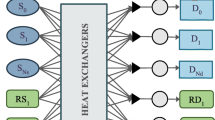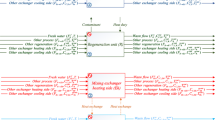Abstract
A new conceptual methodology is proposed to simultaneously integrate water allocation and energy networks with non-isothermal mixing. This method employs a simultaneous model and includes two design steps. In the first step, the water allocation network (WAN), which could achieve the targets of saving water and energy, is obtained by taking account the temperature factor into the design procedure. The optimized targets of both freshwater and energy are reached at this step which ensures this approach is a simultaneous one. In the second step, based on the obtained WAN, the whole water allocation and heat exchange network (WAHEN) is combined with the non-isothermal mixing to reduce the number of heat exchangers. The thus obtained WAHEN can achieve three optimization targets (minimization of water, energy and the number of heat exchangers). Furthermore, the effectivity of our method has been demonstrated by solving two literature examples.

Similar content being viewed by others
References
Chen Z Y, Wang J T. Heat, mass, and work exchange networks. Frontiers of Chemical Science Engineering, 2012, 6(4): 484–502
Savelski M J, Bagejewicz M J. Design and retrofit of water utilization systems in refineries and process plants. AIChE Annual Meeting, Los Angeles, 1997
Ahmetovic E, Ibric N, Kravanja Z, Grossmann I E. Water and energy integration: A comprehensive literature review of nonisothermal water network synthesis. Computers & Chemical Engineering, 2015, 82: 144–171
Bagajewicz M J, Pham R, Manousiouthakis V. On the state space approach to mass/heat exchanger network design. Chemical Engineering Science, 1998, 53(14): 2595–2621
Bagajewicz M J, Rodera H, Savelski M. Energy efficient water utilization systems in process plants. Computers & Chemical Engineering, 2002, 26(1): 59–79
Dong H G, Lin C Y, Chang C T. Simultaneous optimization approach for integrated water-allocation and heat-exchange networks. Chemical Engineering Science, 2008, 63(14): 3664–3678
Liao ZW, Rong G, Wang J D, Yang Y R. Systematic optimization of heat-integrated water allocation networks. Industrial & Engineering Chemistry Research, 2011, 50(11): 6713–6727
Chen Z Y, Hou Y L, Li X D, Wang J T. Simultaneous optimization of water and heat exchange networks. Korean Journal of Chemical Engineering, 2014, 31(4): 558–567
Bogataj M, Bagajewicz M J. Design of non-isothermal process water networks. 17th European Symposium on Computer Aided Process Engineering. Computer Aided Chemical Engineering, 2007, 24: 377–382
Bogataj M, Bagajewicz M J. Synthesis of non-isothermal heat integrated water networks in chemical processes. Computers & Chemical Engineering, 2008, 32(12): 3130–3142
Boix M, Pibouleau L, Montastruc L, Azzaro-Pantel C, Domenech S. Minimizing water and energy consumptions in water and heat exchange networks. Applied Thermal Engineering, 2012, 36: 442–455
Manan Z A, Tea S Y, Wan S R. A new technique for simultaneous water and energy minimization in process plant. Chemical Engineering Research & Design, 2009, 87(11): 1509–1519
George J, Sahu G C, Bandyopadhyay S. Heat integration in process water networks. Industrial & Engineering Chemistry Research, 2011, 50(7): 3695–3704
Thongpreecha S, Siemanond K. Water and heat exchanger network design for fixed-flowrate system. Chemical Engineering Transactions, 2014, 39: 193–198
Huang Y L, Edgar T F. Knowledge based design approach for the simultaneous minimization of waste generation and energy consumption in a petroleum refinery. In: Rossiter A P, ed. Waste Minimization Through Process Design. New York: McGraw-Hill Companies, 1995, 181–196
Savulescu L, Smith R. Simultaneous energy and water minimisation. AIChE Annual Meeting, Miami Beach, Florida, 1998
Savulescu L E, Kim J, Smith R. Studies on simultaneous energy and water minimisation–Part I: Systems with no water re-use. Chemical Engineering Science, 2005, 60(12): 3279–3290
Savulescu L E, Kim J K, Smith R. Studies on simultaneous energy and water minimization–Part II: Systems with maximum re-use of water. Chemical Engineering Science, 2005, 60(12): 3291–3308
Wan Alwi S R, Ismail A, Manan Z A, Handani Z B. A new graphical approach for simultaneous mass and energy minimization. Applied Thermal Engineering, 2011, 31(6-7): 1021–1030
Leewongtanawit B, Kim J K. Improving energy recovery for water minimisation. Energy, 2009, 34(7): 880–893
Martínez-Patiño J, Picón-Núñez M, Serra L M, Verda V. Systematic approach for the synthesis of water and energy networks. Applied Thermal Engineering, 2012, 48: 458–464
Hou Y L, Wang J T, Chen Z Y, Li X D, Zhang J L. Simultaneous integration of water and energy on conceptual methodology for both single- and multi-contaminant problems. Chemical Engineering Science, 2014, 117: 436–444
Liu Z Y, Yang Y, Wan L Z, Wang X, Hou K H. A heuristic design procedure for water-using networks with multiple contaminants. AIChE Journal. American Institute of Chemical Engineers, 2009, 55 (2): 374–382
Zheng X S, Feng X, Cao D L. Design water allocation network with minimum freshwater and energy consumption. Process System Engineering, 2003, 388–393
Feng X, Li Y C, Shen R J. A new approach to design energy efficient water allocation networks. Applied Thermal Engineering, 2009, 29 (11-12): 2302–2307
Wang Y P, Smith R. Waste-water minimisation. Chemical Engineering Science, 1994, 49(7): 981–1006
Acknowledgements
This work was supported by a grant from the National Basic Research Development Program of China (No. 2012CB720305), the National Natural Science Foundation of China (Grant No. 21376162), the Science and Technology Planning Project of Shandong Provincial Education Department of China (No. J15LC16), and Qingdao Science and Technology Planning Project of China (No. 15-9-2-113-nsh).
Author information
Authors and Affiliations
Corresponding authors
Rights and permissions
About this article
Cite this article
Hou, Y., Xie, W., Duan, Z. et al. A conceptual methodology for simultaneous optimization of water and heat with non-isothermal mixing. Front. Chem. Sci. Eng. 11, 154–165 (2017). https://doi.org/10.1007/s11705-016-1593-z
Received:
Accepted:
Published:
Issue Date:
DOI: https://doi.org/10.1007/s11705-016-1593-z




